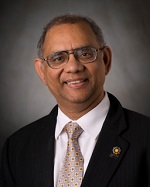Thin-Film Solar Cells with Graded-Bandgap Compound Semiconductor Layers
Hosted By: Thin Films Technical Group
27 May 2023 10:00 - 11:00
Eastern Time (US & Canada) (UTC -05:00)Small-scale photovoltaic generation of energy must become ubiquitous to satisfy the global demand for eco-responsible sources of cheap energy to arrive at the net-zero goal by 2050. Thin-film solar cells are a viable option in addition to crystalline-silicon solar cells due to low cost and ease of manufacturing. But their efficiencies have to be higher for commercial viability.
In this webinar hosted by the Thin Films Technical Group, Akhlesh Lakhtakia will discuss how a coupled optoelectronic model was formulated and implemented along with the differential evolution algorithm to assess the efficacy of grading the bandgap of the absorber layer in three thin-film solar cells. Optimal nonlinear grading is predicted to deliver about 28% efficiency with a 2200-nm-thick CIGS absorber layer in the CIGS solar cell. The use of such solar cells in concentration phototovoltaic systems can enhance the efficiency further, because the electron-hole-pair generation rate grows linearly with concentration but the electron-hole recombination rate grows more slowly. For colored solar cells to be used in building-integrated photovoltaic systems, efficiency loss is predicted to range between 10% and 20%, depending upon the percentage and spectral range of incoming solar photons rejected.
Subject Matter Level: Introductory - Assumes little previous knowledge of the topic
What You Will Learn:
• Rigorous optical and electrical submodels
• Compositional grading for bandgap grading
• Coloration strategies
Who Should Attend:
• Electrical engineering/applied physics/optics graduate students
• Post-doctoral researchers working on solar cells
• Thin-film researchers curious about eco-responsible energy sources
About the Presenter: Akhlesh Lakhtakia from The Pennsylvania State University
 Akhlesh Lakhtakia received the BTech and DSc degrees from the Banaras Hindu University and the MS and PhD degrees from the University of Utah. In 1983 he joined Penn State, where he became the Charles Godfrey Binder Professor and the Evan Pugh University Professor of Engineering Science and Mechanics. His current research interests include electromagnetic scattering, surface multiplasmonics, bioreplication, forensic science, solar cells, sculptured thin films, and mimumes. He has been elected a fellow of Optica, SPIE, IoP, APS, RSC, RSA, IEEE, and AAAS. He received the 2010 Technical Achievement Award from SPIE, the 2016 Walston Chubb Award for Innovation from Sigma Xi, the 2022 Smart Structures and Materials Lifetime Achievement Award, and the 2022 IEEE APS Distinguished Achievement Award. He is a Sigma Xi Distinguished Lecturer (2022–24) and a US State Department Jefferson Science Fellow (2022-23).
Akhlesh Lakhtakia received the BTech and DSc degrees from the Banaras Hindu University and the MS and PhD degrees from the University of Utah. In 1983 he joined Penn State, where he became the Charles Godfrey Binder Professor and the Evan Pugh University Professor of Engineering Science and Mechanics. His current research interests include electromagnetic scattering, surface multiplasmonics, bioreplication, forensic science, solar cells, sculptured thin films, and mimumes. He has been elected a fellow of Optica, SPIE, IoP, APS, RSC, RSA, IEEE, and AAAS. He received the 2010 Technical Achievement Award from SPIE, the 2016 Walston Chubb Award for Innovation from Sigma Xi, the 2022 Smart Structures and Materials Lifetime Achievement Award, and the 2022 IEEE APS Distinguished Achievement Award. He is a Sigma Xi Distinguished Lecturer (2022–24) and a US State Department Jefferson Science Fellow (2022-23).
